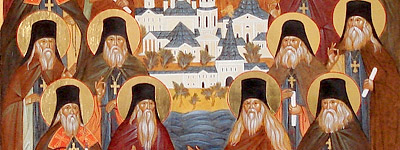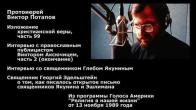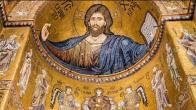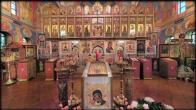You are here
Optina Elders

Elder Makary's face was scarred by smallpox, he stuttered and was always poorly dressed, but he was distinguished by a very refined personality. He was born to a landed gentry family, loved music and was a talented violinist. (REIDMAN) SCHEMA-ARCHIMANDRITE AVRAAM | 06 MARCH 2007
The Startsi of Optina Monastery are holy fathers Moses, Antony, Leonid(Lev), Macarius, Hilarion, Ambrose, Anatolius I, Isaac I, Joseph, Barsanuphius, Anatolius the Younger, Nectarius, Nikon the Confessor, and Hieromartyr Isaac the Younger. Hieromartyr Isaac was shot by the Bolsheviks on December 26 1937. The holy Fathers made the Optina Hermitage (Pustyn) a focus for the powerful renewal movement that spread through the Church in Russia beginning early in the nineteenth century, and continuing up to (and even into) the atheist persecutions of the twentieth century. Saint Paisius Velichkovsky (November 15) was powerfully influential in bringing the almost-lost hesychastic tradition of Orthodox spirituality to Russia in the eighteenth century, and his labors found in Optina Monastery a ‘headquarters’ from which they spread throughout the Russian land. The monastery itself had been in existence since at least the sixteenth century, but had fallen into decay through the anti-monastic policies of Catherine II and other modernizing rulers. Around 1790, Metropolitan Platon of Moscow undertook a mission to restore and revive the monastery in the tradition set forth by St Paisius. By the early 1800s the monastery (located about 80 miles from Moscow) had become a beacon of Orthodox spirituality, partly through their publication of Orthodox spiritual texts, but more importantly through the lineage of divinely-enlightened spiritual fathers (startsi, plural of starets) who served as guides to those, noble and peasant, who flocked to the monastery for their holy counsel. The fathers aroused some controversy in their own day; a few critics (some of them from other monasteries) disapproved of their allowing the Jesus Prayer to become widely-known among the people, fearing that it would give rise to spiritual delusion (prelest). For a wonderful depiction of the deep influence of the Jesus Prayer on Russian life during this period, read the anonymously-written Way of a Pilgrim. With the coming of the Russian Revolution in 1917, the monastery was of course officially shut down, but some of the Fathers were able to keep it running for a time as an ‘agricultural legion’. Over the years, most of the Fathers were dispersed, to die in exile, in prison camps, or by the firing squad. Many of them are known to have continued to function as startsi to their spiritual children, despite great danger and hardship, for the remainder of their time on earth. Commemoration of the Optina startsi was approved by the Synod of the Russian Church Abroad in 1990, and by the Moscow Patriarchate in 1996. The Optina Monastery itself was officially re-established in 1987.
Schema-Archimandrite Moses
As a youth, Elder Moses received St. Seraphim’s blessing to enter the monastic life. He was 16 when he joined the Roslavl forest ascetics, among whom were disciples of Elder Paisius Velichkovsky, and for 14 years he exercised himself in spiritual warfare and inner concentration under their tutelage. Forced to move by the War of 1812, he lived for a time with ascetics in the Briansk forest where he forged ties with Elder Leonid. In 1821 he visited Optina, which had been revived by Paisian disciples not long before, and he was persuaded to stay and establish nearby a skete. With his younger brother Anthony and two other monks he began building, and a year later the skete church was consecrated. In 1825 Moses was appointed superior of the Hermitage, while his brother succeeded him as head of the skete. Elder Moses greatly expanded the physical plant of the Hermitage: he built the St. Mary of Egypt refectory church, additional cells for the brethren; he added stables, a kiln, a large library and an apiary. More importantly, he strengthened its spiritual foundation by inviting Elder Leonid to Optina and himself setting an example of utmost obedience and meekness. After Elder Leonid arrived, he did nothing without his blessing. His love and gentleness attracted many pilgrims, with their financial support, but his true spiritual stature remained largely hidden, just as his life was hidden in God.
Schema-Hegumen Anthony
Elder Anthony was discipled by his brother in the Roslavl forest before following him to Optina. He was only 30 when he was appointed superior of the skete, and even in this position of authority he did nothing without his brother’s blessing. Visitors to the Skete were impressed by the order and cleanliness, which were mirrored in the inner tranquility of the brethren under the care of this spirit-bearing elder. The diocesan bishop, however, saw the revival of eldership as an innovation and made things difficult for the elders. In 1839 he transferred Elder Anthony to the derelict Maloyaroslavl monastery. Leaving Optina was a great trial for the Elder, but nevertheless, he applied himself to revitalizing the monastery and endured 14 years before returning to his beloved Optina for retirement. For 30 years the Elder suffered from sores on his legs which, in time, penetrated to the bone. Even in this condition he did not spare himself for the sake of his brother. One monk often gave in to a weakness to oversleep and missed Matins, which was served at 1 or 2 in the morning; finally he gave up altogether, in spite of repeated entreaties by his superiors. One morning after service in church Elder Anthony came to the brother’s cell. “I must give an account for you. Have pity on me and on your’ own’ soul,” the Elder implored. He prostrated himself before the brother, whereupon blood poured out from the elder’s boots, forming a pool beneath his mantia. The brother was cured of his weakness.
Hieroschemamonk Leonid
Eldership at Optina properly begin with Elder Leonid (Leo in schema) who arrived when was already matured in this ministry. Outwardly his monastic path was unsettled. It began in Optina at the dawn of its revival, initiated in 1795 Metropolitan Platen, then led to White Banks Monastery where he was tonsured, to Cholnsk, the Roslavi forest, Valaam, St. Alexander of Svir monastery, Ploshchansk and the Briansk forest, before “returned” to Optina in 1829 at the invitation Elder Moses. This transience was the result not of instability but of circumstance. The tradition eldership and hesychasm had become so removed from the Russian monastic experience of the 18th century that it was suspected of being an innovation and not infrequently aroused misunderstandings leading to slander, jealousy and outright persecution – something which Elder Leonid experienced at varying degrees throughout his monastic career, and particularly in his last years at Optina. Leonid’s involuntary mobility did not, however, prevent him fro developing a solid spiritual foundation. In his sojournings he was in constant cent with Paisian disciples, and spent some twenty years in the company of Elder Cleopas and Elder Theodore (of Svir) who had lived with Elder Paisius. From them Leonid learned the art of unceasing prayer. At Optina the brethren came daily to Elder Leonid to reveal their thoughts practice which nurtured spiritual vigilance and control. With his gift of clairvoyance, the Elder expertly wielded the spiritual scalpel, going directly to the heart of the person’s problem and inspiring healing tears of repentance. He worked countless miracles also among laymen. In the world he had been engaged in commerce and this, experience helped him to establish a rapport with pilgrims from diverse backgrounds. At first acquaintance many were misled by the rather jovial exterior which often hid his ascetic temperament. Trials were bound to follow this soul-saving activity. The same authority which sent Elder Anthony from Optina forbade Elder Leonid from receiving visitors. But people continued to flock to him with their troubles and, possessing great love and compassion, he could not refuse them. Fortunately, he received moral supp from Elder Moses and also Metropolitans Philaret of Moscow and of Kiev. But the tension was wearying. Elder Leonid died after a serious illness of five weeks.
Hieroschemamonk Macarius
Elder Makary’s face was scarred by smallpox, he stuttered and was always poorly dressed, but he was distinguished by a very refined personality. He was born to a landed gentry family, loved music and was a talented violinist. After some years’ experience in the world as a bookkeeper, in 1818 he entered upon the monastic path at the Ploshchansk Hermitage. There he formed ties with Elder Leonid and followed him to Optina. With Elder Leonid’s repose, the burden of the spiritual guidance of the skete fell to Elder Makary. He was soft-spoken and emanated a quiet joy in the Lord. Like Elder Leonid, he used his gift of spiritual discernment to work numerous healings, especially of the demon-possessed. also carried on a tremendous correspondence: his letters of counsel fill two volumes, each numbering a thousand pages. Elder Makary did not tolerate idleness among the brethren. He introduced various handcrafts: bookbinding and woodworking. He also adorned the skete with mass planting of flowers. His greatest contribution to Optina, however, to initiate its work of publishing patristic texts. This was historically significant since Peter’s reforms had greatly curtailed such activity which subsequent laws restricted to ecclesiastical print shops. The result was that many works of Holy Fathers existed only in manuscript form or in very limited editions. Meanwhile, the secular press was churning out translations of mystical-philosophical works from the West, some of them plainly hostile to Orthodoxy. With the blessing and earnest support of Metropolitan Philaret of Moscow, and the active collaboration of the Orthodox writer and philosopher Ivan Kireyevsky, Elder Makary began meticulously editing manuscripts translated from the Greek by Paisius Velichkovsky, which he had acquired in Ploshchansk, and other patristic manuscripts donated by various individuals, thus launching an undertaking which, in 50 years, produced more than 125 books in 225,090 copies. These were sent to libraries and seminaries all over Russia, putting into circulation the works of St. Isaac the Syrian, St. Symeon the New Theologian, St. Nil of Sera, Elder Paisius and others, and inspiring a growing circle of religiously inclined intelligentsia.
Hieroschemamonk Hilarion
Elder Hilarion was born on Pascha night and baptized Rodion. In the world he was a tailor and ran a clothing store, devoting his spare time to missionary work among the schismatic Skoptsy. He spent a year visiting various monasteries before settling in Optina in 1839, drawn by the presence of Elders Leonid and Makary. When the latter was appointed skete superior, he chose Rodion as his cell attendant, an obedience he fulfilled for 20 years, until Elder Makary’s repose. In addition he worked in the gardens, made kvass, baked bread and looked after the apiary He was characterized by simplicity, goodwill and a readiness to help. With his missionary background he showed special concern for those outside the Church. Although he remained for posterity in the shadow of his more famous fellow elders, his spiritual greatness may be judged by the fact that Elder Makary entrusted to him, as well as to Elder Ambrose, his spiritual children. Appointed skete superior and father confessor in 1863, Elder Hilarion tried to plant love and oneness of mind in the hearts of the brethren, and continued the order established by Elder Makary, following the pattern of his abba’s wise instructions as if he were still his obedient cell-attendant. During a painful illness in the last two years of his life, he asked not for healing but for patience and fulfilled his cell rule to the end.
Hieroschemamonk Ambrose
The sixth of eight children, the future Elder had a lively humor and sociable personality which conflicted with his spiritual yearnings. A serious illness helped him to resolve his inner struggle. He arrived at Optina in 1839 when the monastery was spiritually in full bloom. Guided at first by Elder Leonid and then by Elder Makary who chose him as his cell-attendant, he made rapid spiritual progress. After only three years he was tonsured and in another three years he was ordained hieromonk. Illness forced him into semi-reclusion for several years, enabling him with great profit to concentrate on the Jesus Prayer and to experience the meaning of hesychia, the silence of the soul before God. Plagued by a weak constitution for the rest of his life, he continued nevertheless to expend every effort at first in assisting Elder Makary with the translation of the Holy Fathers, with his correspondence and in conveying his counsel to pilgrims, and later as an elder in his own right for the sake of that love which beareth all. For 30 years alter Elder Makary’s death, Elder Ambrose was in the position of being Optina’s principal starets. Countless pilgrims streamed to his cell, and even when he was thoroughly exhausted and had to receive them lying in bed, he never turned away anyone in need of soul-profiting counsel. Men’s souls held no secrets from him; abundant testimony exists of his clairvoyance. He always adapted his advice to the individual and no one’s problem was considered too insignificant. Dostoevsky found in Elder Ambrose a living example of the Christian ideal, while Elder Nektary callcd him “an earthly angel and a heavenly man.” Indeed, he was seen more than once surrounded by uncreated light, a sign of transfiguration and citizenship in paradise.
Hieroschemamonk Anatole (Zertsalov)
Elder Anatole’s parents encouraged their children towards monasticism. After attending seminary, a miraculous healing from consumption led him to Optina. He was discipled by Elder Makary who, foreseeing his future greatness, jokingly called him “the tall one”. He had a difficult novitiate, working in the kitchen and sleeping there on a woodpile. In 1870 he became a hieromonk and then, at Elder Ambrose’s request, skete superior. With his exceptional gift of prayer, he was in great demand as a spiritual father and received up to 200 letters a day. He often forewarned people of impending trials, counselling submission to God’s will. He worked closely with Elder Ambrose who, recognizing his rare spiritual gifts, depended on his help in guiding the Shamardino nuns. When Elder Ambrose reposed, Fr. Anatole felt orphaned, although he was consoled by ties with St. John of Kronstadt, Like so many of the elders, Elder Anatole suffered from slanders, a trial which further weakened his heart and hastened his departure from this world. In 1893 he was secretly tonsured into the great schema and three and a haft months later he reposed. Donate Share <\> CODE FOR BLOG Since you are here… …we do have a small request. More and more people visit Orthodoxy and the World website. However, resources for editorial are scarce. In comparison to some mass media, we do not make paid subscription. It is our deepest belief that preaching Christ for money is wrong. Having said that, Pravmir provides daily articles from an autonomous news service, weekly wall newspaper for churches, lectorium, photos, videos, hosting and servers. Editors and translators work together towards one goal: to make our four websites possible - Pravmir.ru, Neinvalid.ru, Matrony.ru and Pravmir.com. Therefore our request for help is understandable. For example, 5 euros a month is it a lot or little? A cup of coffee? It is not that much for a family budget, but it is a significant amount for Pravmir. If everyone reading Pravmir could donate 5 euros a month, they would contribute greatly to our ability to spread the word of Christ, Orthodoxy, life's purpose, family and society.
Relics in cathedral - monthly calendar
| S | M | T | W | T | F | S |
|---|---|---|---|---|---|---|
|
|
|
|
|
|
1
|
2
|
|
3
|
4
|
5
|
6
|
7
|
8
|
9
|
|
10
|
11
|
12
|
13
|
14
|
15
|
16
|
|
17
|
18
|
19
|
20
|
21
|
22
|
23
|
|
24
|
25
|
26
|
27
|
28
|
29
|
30
|
PARISH LIFE
Address of our Cathedral
While all the materials on this site are copyrighted, you may use them freely as long as you treat them
with respect and provide attribution on the Russian Orthodox Cathedral of St.John the Baptist of Washington DC.









